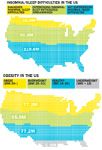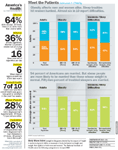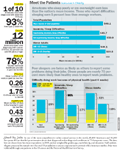Meet the Patients
Pharmaceutical Executive
Pharma's ultimate customers are overweight and can't sleep. Ever wonder what they say about that? The National Health and Wellness Survey asked.
Doctors aren't the only ones who decide if a patient gets a particular drug. Third-party payers have a say and, increasingly, so do patients. For nearly a decade, pharma companies have been talking directly to the people who ingest their products. But the patients aren't always talking back. When the 2005 National Health and Wellness Survey asked patients about their health, the results were astonishing—particularly when it comes to insomnia and obesity.

More than 77 million Americans are obese, and 66 million more are overweight. Nationwide, more than 95 million people report insomnia or difficulty sleeping. Women have more trouble sleeping than men, but men and women are equally likely to be severely overweight. Married adults tend to obesity more than single people, while lower-income Americans suffer most often from both insomnia and obesity.

Body Mass Index (weight in kilograms divided by the square of height in meters) (kg/m2) BMI is a measure of body fat based on height and weight that applies to both men and women. The National Institute of Health uses the following categories to interpret BMI.

About the Data In one of the most comprehensive online annual surveys in the world, 41,000 Americans and 36,000 Europeans fill out detailed questionnaires about their diagnosed and undiagnosed conditions in 75 therapeutic areas. The data here are drawn from American respondents in 2005, and are weighted by gender, age, race/ethnicity, and education. Staff epidemiologists projected the sample onto the total US population to create a representative portrait of the American market. Data were validated through comparisons to the US census and the National Health Interview Survey.

Addressing Disparities in Psoriasis Trials: Takeda's Strategies for Inclusivity in Clinical Research
April 14th 2025LaShell Robinson, Head of Global Feasibility and Trial Equity at Takeda, speaks about the company's strategies to engage patients in underrepresented populations in its phase III psoriasis trials.
Beyond the Prescription: Pharma's Role in Digital Health Conversations
April 1st 2025Join us for an insightful conversation with Jennifer Harakal, Head of Regulatory Affairs at Canopy Life Sciences, as we unpack the evolving intersection of social media and healthcare decisions. Discover how pharmaceutical companies can navigate regulatory challenges while meaningfully engaging with consumers in digital spaces. Jennifer shares expert strategies for responsible marketing, working with influencers, and creating educational content that bridges the gap between patients and healthcare providers. A must-listen for pharma marketers looking to build trust and compliance in today's social media landscape.
Bristol Myers Squibb’s Cobenfy Falls Short in Phase III Trial as Add On Therapy for Schizophrenia
April 23rd 2025In the Phase III ARISE trial, Cobenfy administered as an adjunctive treatment to atypical antipsychotics for patients with inadequately controlled schizophrenia did not achieve statistically significant improvements.